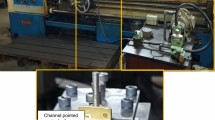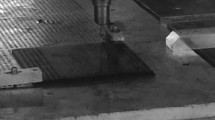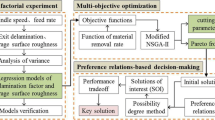Abstract
This work presents an optimization technique using genetic algorithm for efficient core drilling in basalt rock. Optimization of the compact core-drilling problem is based on maximizing a desirability function which accounts for (a) maximizing the drilling feed while minimizing tool-wear progression, (b) minimizing the thrust force and torque (power), and (c) satisfying realistic constraints related to process parameters. The resulting set of optimized cutting parameters is sought in order to make the tool last longer while effectively drilling with high productivity. A room temperature model to relate the experimental data on changing drill forces and torques required by the progressive tool wear, and developed in a previous paper, is used in this study.
Similar content being viewed by others
References
Fergason RL, Christensen PR, Bell JF III, Golombek MP, Herkenhoff KE, Kieffer HH (2006) Physical properties of the Mars exploration rover landing sites as inferred from mini-TES–derived thermal inertia. J Geophysical Research 111:E02S21
Fernandes M, Cook C (2006) Drilling of carbon composites using a one shot drill bit. Part II: empirical modeling of maximum thrust force. Int J of Machine Tools and Manufacture 46(1):76–79
Lia ZC, Jiaoa Y, Deinesa TW, Peia ZJ, Treadwell C (2005) Rotary ultrasonic machining of ceramic matrix composites: feasibility study and designed experiments. Int J Mach Tool Manuf 45:1402–1411
Glowka DA (1989) Use of single cutter data in the analysis of PDC bit designs: part 1—development of a PDC cutting force model. J Petrol Tech 41(8):797–799 (844–849)
Glowka DA (1989) Use of single-cutter data in the analysis of PDC Bit designs: part 2—development and use of the PDCWEAR computer code. J Petroleum Technology 41(8):850–859
Tulu IB, Heasley KA, Bilgesu I, Sunal O (2008) Modeling rock and drill cutter behavior. In: 42nd U.S. rock mechanics—2nd U.S.–Canada rock mechanics symposium 2008 proceedings, San Francisco, CA, USA, 29 June–2 July 2008
Zacny KA, Cooper GA (2004) Investigation of diamond-impregnated drill bit wear while drilling under Earth and Mars conditions. J Geophys Res 109(E7):E07S10
Hamade RF, Manthri SP, Pusavec F, Zacny KA, Taylor LA, Dillon OW Jr, Rouch K, Jawahir IS (2008) Modeling and optimization of PCD compact core drilling of basalt rock, CIRP-ICME’08. Naples, Italy
Hamade RF, Manthri SP, Pusavec F, Zacny KA, Taylor LA, Dillon Jr. OW, Rouch K, Jawahir IS (2009) Developing a methodology towards sustainable PCD compact core drilling on planet Mars, IMECE2009-10133. In: Proceedings of the ASME international mechanical engineering congress and exposition, Lake Buena Vista, FL, USA.
Hamade RF, Manthri SP, Pusavec F, Zacny KA, Taylor LA, Dillon OW Jr, Rouch K, Jawahir IS (2010) Compact core drilling in basalt rock using PCD tool inserts: wear characteristics and cutting forces. J Mater Process Technol 210:1326–1339
Bourgoyne AT, Young FS Jr (1974) A multiple regression approach to optimal drilling and abnormal pressure detection. Paper SPE 4238, Trans, AIME, Soc Pet Eng J 257:371–384
Judzis A, Bland RG, Curry DA, Black AD, Robertson HA, Meiners MJ, Grant TC (2009) Optimization of deep-drilling performance—benchmark testing drives ROP improvements for bits and drilling fluids. SPE Drill Complet 24(1):25–39
Venet V, Henry JP, Fourmaintraux D (1993) Contribution to the optimizing of core drilling by modeling the initiation of discing. Revue de L Institut Francais Du Petrole 48(1):15–42
Yinghui L, Mavroidis C, Bar-Cohen Y, Zensheu C (2007) Analytical and experimental study of determining the optimal number of wedge shape cutting teeth in coring bits used in percussive drilling. J Manuf Sci Eng (Trans ASME) 129(4):760–769
Holland JH (1992) Adaptation in natural and artificial systems. University of Michigan Press, Michigan
Malakooti B, Deviprasad J (1989) An interactive multiple criteria approach for parameter selection in metal cutting. Oper Res 37(5):805–818
Ali-Tavoli M, Nariman-Zadeh N, Khakhali A, Mehran M (2006) Multi-objective optimization of abrasive flow machining processes using polynomial neural networks and genetic algorithms. Mach Sci Technol 10(4):491–510
Sardiñas RQ, Santana MR, Alfonso E, Brindis EA (2006) Genetic algorithm-based multi-objective optimization of cutting parameters in turning processes. Eng Appl Artif Intel 19:127–133
Zhang J-Y, Liang SY, Yao J, Chen JM, Huang JL (2006) Evolutionary optimization of machining processes. J Intell Manuf 17(2):203–215
Wang X, Jawahir IS (2005) Optimization of multi-pass turning operations using genetic algorithms for the selection of cutting conditions and cutting tools with tool-wear effect. Int J Prod Res 43(17):3543–3559
Clayton R, Chen S, Lefort G (2005) New Bit design, cutter technology extend PDC applications to hard rock drilling. In: SPE/IADC drilling conference proceedings, Amsterdam, the Netherlands, 23–25 February 2005
Weaver GE et al. (2000) Method and system for predicting performance of a drilling system for a given formation. US Patent 6109368.
Plinninger RJ, Spaun G, Thuro K (2002) Prediction and classification of tool wear in drill and blast tunneling. In: van Rooy JL and Jermy, CA (eds) Proceedings of 9th congress of the international association for engineering geology and the environment, Durban, South Africa, 16–20 September 2002. ISBN no. 0-620-28559-1. pp 2226–2236.
Wojtanowicz AK, Kuru E (1993) Mathematical modelling of PDC bit drilling process based on a single cutter mechanics. J Energ Resour Tech (Trans ASME) 115(4):247–256
Choudhury SK, Kishore KK (2000) Tool wear measurement in turning using force ratio. Int J Mach Tool Manuf 40:899–909
Hamade RF, Seif CY, Ismail F (2006) Extracting cutting force coefficients from drilling experiments. Int J Mach Tool Manuf 46:387–396
Plinninger RJ, Thuro K (2004) Wear prediction in hard rock excavation using the CERCHAR Abrasiveness Index (CAI). In: Shubert (ed) EUROCK 2004 and 53rd Geomechanics Colloquium, 2004 VGE.
Myers RH, Montgomery DC (1995) Response surface methodology: process and product optimization using designed experiments. Wiley, New York (Probability and Statistics Series)
Author information
Authors and Affiliations
Corresponding author
Rights and permissions
About this article
Cite this article
Hamade, R.F., Pusavec, F., Manthri, S.P. et al. A methodology for the optimization of PCD compact core drilling in basalt rock. Int J Adv Manuf Technol 61, 369–377 (2012). https://doi.org/10.1007/s00170-011-3696-5
Received:
Accepted:
Published:
Issue Date:
DOI: https://doi.org/10.1007/s00170-011-3696-5




